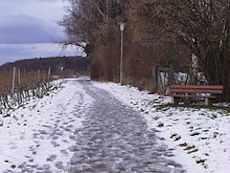Any Connecticut state legislator who affixes to his car the official legislative license plate to which he is entitled may be either impossibly vain or naive. For a legislative license plate is an invitation to the whole world to scrutinize and resent every move by the car's driver, as state Rep. Brandon L. McGee Jr., (D-Hartford), discovered Monday.
Hurrying Friday between a tour of the state Capitol with some of his young constituents and a meeting at his job outside the legislature and having not eaten all day, McGee drove to a doughnut shop near the Capitol and parked in a handicapped spot near the door. While he insists that he was in the shop for no more than three minutes, that was plenty of time for someone to take a photo of the car with the big-shot legislative plate parked in the handicapped spot without a handicapped parking tag.
The photo was posted on a local Internet site and then on Monday on a site devoted to state politics, a site followed closely by the state's political class -- Tom Dudchik's CTCapitolReport.com -- whereupon a torrent of outrage and ridicule began falling on McGee via the Internet, even, he said, death threats.
McGee quickly confessed and apologized in interview after interview, including an interview with a television station that led its 6 p.m. newscast with the supposed scandal before cutting to its usual "weather every 10 seconds" or thereabouts.
The caliber of Connecticut state legislators is not high enough to disprove what H.L. Mencken wrote of the typical legislator decades ago. "If the right pressure could be applied to him," Mencken noted, "he would be cheerfully in favor of polygamy, astrology, or cannibalism." Mainly Connecticut legislators are good at suffering fools lightly.
But that can be hard enough, and most legislators put in a lot of hours, if to no particular effect, and they aren't paid much. Only the richest or most pensioned among them can afford not to have a full-time job outside the legislature, though for at least five months per year the legislature is a full-time job in itself, and even when the legislature is out of session there is often much work to do. That's why even McGee and other inexperienced legislators have been appointed assistant majority leaders, a silly fiction by which they get an additional stipend of a few thousand dollars.
Those license plates are about the only perk ordinary legislators get. As McGee has discovered, handicapped parking tags would be more useful.
McGee has just started his second term, but maybe after a few more terms of running himself ragged in two jobs he will discover the gumption to talk back to hyperbole and trivia.
For who hasn't driven to the store to find occupied all the regular parking spaces within a hundred yards while six handicapped spaces up front are vacant? And how much harm can be done by delaying by a few seconds a handicapped person's descent on a doughnut shop? Does anyone need doughnuts that badly? It's not the entrance to a hospital emergency room.
Of course there's the hypocrisy of it -- legislators making rules for others to follow while exempting themselves. But parking in a handicapped spot without a permit for a few minutes is the least of the hypocrisy of legislating in Connecticut.
If McGee had never parked improperly at the doughnut shop and thus had done nothing to distract from his record of following his party's line, which is to tax the private sector into oblivion to reward special interests in the name of helping the poor, who nevertheless somehow always grow more numerous, he wouldn't have been compelled to apologize for anything, everyone would still consider him a right honorable member, and the TV newscasts would have gone straight to the weather, reporting urgently that January remains cold and dark.
Chris Powell is managing editor of the Journal Inquirer, in Manchester, Conn.














